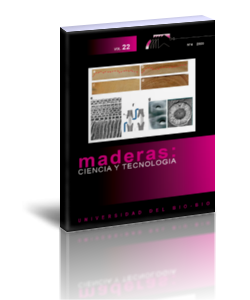Effect of the thermal modification and nano-ZnO impregnation on the deterioration of Caribbean pine wood
Keywords:
Deterioration index, mass loss, nano-zinc oxide particle, termite tunnels, wood deteriorationAbstract
This study aimed to investigate the effect of thermal modification and nano-zinc oxide (nano-ZnO) particle impregnation on the deterioration of Caribbean pine wood under field conditions. Samples were thermally-modified at various temperature levels (control, 180 °C, 200 °C, and 220 °C). Nano-ZnO impregnation was done with an aqueous solution at 1,5 % in an autoclave under two-steps of pressure and vacuum. Unmodified and thermally-modified, non-impregnated and nano-ZnO-impregnated samples were exposed to deterioration for five months in field tests. A deterioration index was used to evaluate the health condition of the samples. The mass loss and occurrence of termite tunnels in percentage were also determined. The nano-ZnO impregnation improved the resistance of unmodified wood to field-deterioration. The thermal modification at 180oC and 200ºC increased the wood deterioration and nano-ZnO impregnation did not improve their resistance. Unmodified and 220 ºC-modified samples had lower mass loss by xylophages than other thermal treatments regardless of the nanoparticle impregnation. The nano-ZnO impregnation decreases the occurrence of termite tunnels in unmodified, 200 ºC and 220 ºC-modified samples.
Downloads
References
Bak, M.; Németh, R. 2018. Effect of different nanoparticle treatments on the decay resistance of wood. BioResources 13(4): 7886-7899. https://ojs.cnr.ncsu.edu/index.php/BioRes/article/view/BioRes_13_4_7886_Bak_Nanoparticle_Decay_Resistance_Wood.
Clausen, C.A; Green, F.; Nami Kartal, S. 2010. Weatherability and leach resistance of wood impregnated with nano-zinc oxide. Nanoscale Res Lett 5(9): 1464-1467. https://doi.org/10.1007/s11671-010-9662-6.
Clausen, C.A.; Kartal, S.N.; Arango, R.A.; Green, F. 2011. The role of particle size of particulate nano-zinc oxide wood preservatives on termite mortality and leach resistance. Nanoscale Res Lett 6: 427. https://doi.org/10.1186/1556-276X-6-427.
Clausen, C.A.; Yang, V.W.; Arango, R. A.; Green, F. 2009. Feasibility of nanozinc oxide as a wood preservative. In Proceedings of American Wood Protection Association 105: 255-260. https://naldc.nal.usda.gov/download/41044/PDF.
Grace, J.K.; Campora, C.E. 2005. Food location and discrimination by subterranean termites (Isoptera: Rhinotermitidae). In Proceedings of International Conference on Urban Pests 437-441.
Guadalupe Rojas, M.; Morales-Ramos, J.A. 2001. Bait matrix for delivery of chitin synthesis inhibitors to the Formosan subterranean termite (Isoptera: Rhinotermitidae). J Econ Entomol 94(2): 506-510. https://doi.org/10.1603/0022-0493-94.2.506.
Kartal, S.N.; Green III, F.; Clausen, C.A. 2009. Do the unique properties of nanometals affect leachability or efficacy against fungi and termites? Inter Biodeter Biodegr 63(4): 490-495. https://doi.org/10.1016/j.ibiod.2009.01.007.
Lepage, E.S. 1970. Método Sugerido pela IUFRO para ensaios de campo com estacas de madeira. Preservação de madeiras 1: 205-216.
Lima, J.T.; Costa-Leonardo, A.M. 2014. Foraging in subterranean termites (Isoptera: Rhinotermitidae): how do Heterotermes tenuis and Coptotermes gestroi behave when they locate equivalent food resources? B Entomol Res 10(4): 525-533. https://doi.org/10.1017/S0007485314000297.
Lykidis, C.; Bak, M.; Mantanis, G.; Németh, R. 2016. Biological resistance of pine wood treated with nano-sized zinc oxide and zinc borate against brown-rot fungi. Eur J Wood Wood Prod 74(6): 909-911. https://doi.org/10.1007/s00107-016-1093-3.
Lykidis, C.; Mantanis, G.; Adamopoulos, S.; Kalafata, K. 2013. Arabatzis, I. Effects of nano-sized zinc oxide and zinc borate impregnation on brown rot resistance of black pine (Pinus nigra L.) wood. Wood Mater Sci Eng 8(4): 242-244. https://doi.org/10.1080/17480272.2013.834969.
Lykidis, C.; Troyab, T. De.; Condeb, M.; Galvánc, J.; Mantanisd, G. 2018. Termite resistance of beech wood treated with zinc oxide and zinc borate nanocompounds. Wood Mater Sci Eng 13(1): 45-49. https://doi.org/10.1080/17480272.2016.1257651.
Mantanis, G.; Terzi, E.; Kartal, S. N.; Papadopoulos, A. N. 2014. Evaluation of mold, decay and termite resistance of pine wood treated with zinc- and copper-based nanocompounds. Int Biodeter Biodegr 90: 140-144 https://doi.org/10.1016/j.ibiod.2014.02.010.
Marzbani, P.; Afrouzi, Y.; Omidvar, A. 2015. The effect of nano-zinc oxide on particleboard decay resistance. Maderas-Cienc tecnol 17(1): 63-68. http://dx.doi.org/10.4067/S0718-221X2015005000007.
Németh, R.; Bak, M.; Yimmou, B.M.; Csupor, K.; Molnár, S.; Csóka, L. 2013. Nano-zink as an agent against wood destroying fungi. In Wood the Best Material for Mankind. Kúdela, J.; Babiak, M. (eds). Arbora Publishers, Zvolen, Slovakia. https://iaws-web.org/files/file/Zborn%C3%ADk%202012.pdf.
Paes, J.B.; Segundinho, P.G.A., Euflosino, A.E.R.S., Oliveira, J.G.L. 2015. Resistance of thermally treated woods to Nasutitermes corniger in a food preference test. Madera Bosques 21(1): 157-164. https://doi.org/10.21829/myb.2015.211439.
Pessoa, A.M.C.; Berti Filho, E.; Brito, J.O. 2006. Evaluation of the Eucalyptus grandis thermorectificated wood submitted to the drywood termite attack, Cryptotermes brevis. Sci For 72: 11-16. https://www.ipef.br/publicacoes/scientia/nr72/cap01.pdf.
Salman, S.; Thévenon, M.F.; Pétrissans, A.; Dumarçay, S.; Candelier, K.; Gérardin, P. 2017. Improvement of the durability of heat-treated wood against termites. Maderas-Cienc Tecnol 19(3): 317-328. http://dx.doi.org/10.4067/S0718-221X2017005000027.
Sivrikaya, H.; Can, A.; Troya, T.; Conde, M. 2015. Comparative biological resistance of differently thermal modified wood species against decay fungi, Reticulitermes grassei and Hylotrues bajulus. Maderas-Cienc Tecnol 17(3): 559-570. http://dx.doi.org/10.4067/S0718-221X2015005000050.
Taghiyari, H.R.; Kalantari, A.; Ghorbani, M.; Bavaneghi, F.; Akhtari, M. 2015. Effects of fungal exposure on air and liquid permeability of nanosilverand nanozincoxide-impregnated Paulownia wood. Int Biodeter Biodegr 105: 51-57. https://doi.org/10.1016/j.ibiod.2015.08.014.
Trevisan, H.; Latorraca, J.V.F.; Santos, A.L.P.; Teixeira, J.G.; Carvalho, A.G. 2014. Analysis of rigidity and deterioration from exposure in a decay test field of thermorectificated Eucalyptus grandis wood. Maderas-Cienc Tecnol 16(22): 217-226. http://dx.doi.org/10.4067/S0718-221X2014005000017.
Tripathi, S.; Pant, H.; Kashyap, A.K. 2014. Decay resistance against Basidiomycetes fungi of hart-treated Pinus roxburghii and Mangifera indica wood. J Trop For Sci 26(2): 203-207. https://www.jstor.org/stable/23723905?seq=1.
Valle, M.L.A.; Silva, J.C.; Della Lucia, R.M.; Evangelista, W.V. 2013. Retention and penetration of CCA in wood of first and second rotation of Eucalyptus urophylla S.T. Blake. Cienc Florest 23(2): 481-490. https://doi.org/10.5902/198050989292.
Vidal, J.M.; Evangelista, W.V.; Silva, J.C.; Jankowsky, I.P. 2015. Preservação de madeiras no Brasil: histórico, cenário atual e tendências. Cienc Florest 25(1): 257-271. https://doi.org/10.1590/1980-509820152505257.

































